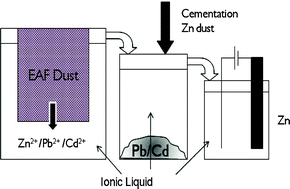Processing of metals and metal oxides using ionic liquids
Abstract
Hydrometallurgy lies at the heart of many industrial processes and is the source of a large volume of aqueous waste. Treating dilute streams of acidic and basic by-products is both energy and chemical intensive, and is one of the largest sources of metal-based emissions into the environment. Over the past decade, numerous studies have been made into the use of ionic liquids for metal dissolution,


 Please wait while we load your content...
Please wait while we load your content...